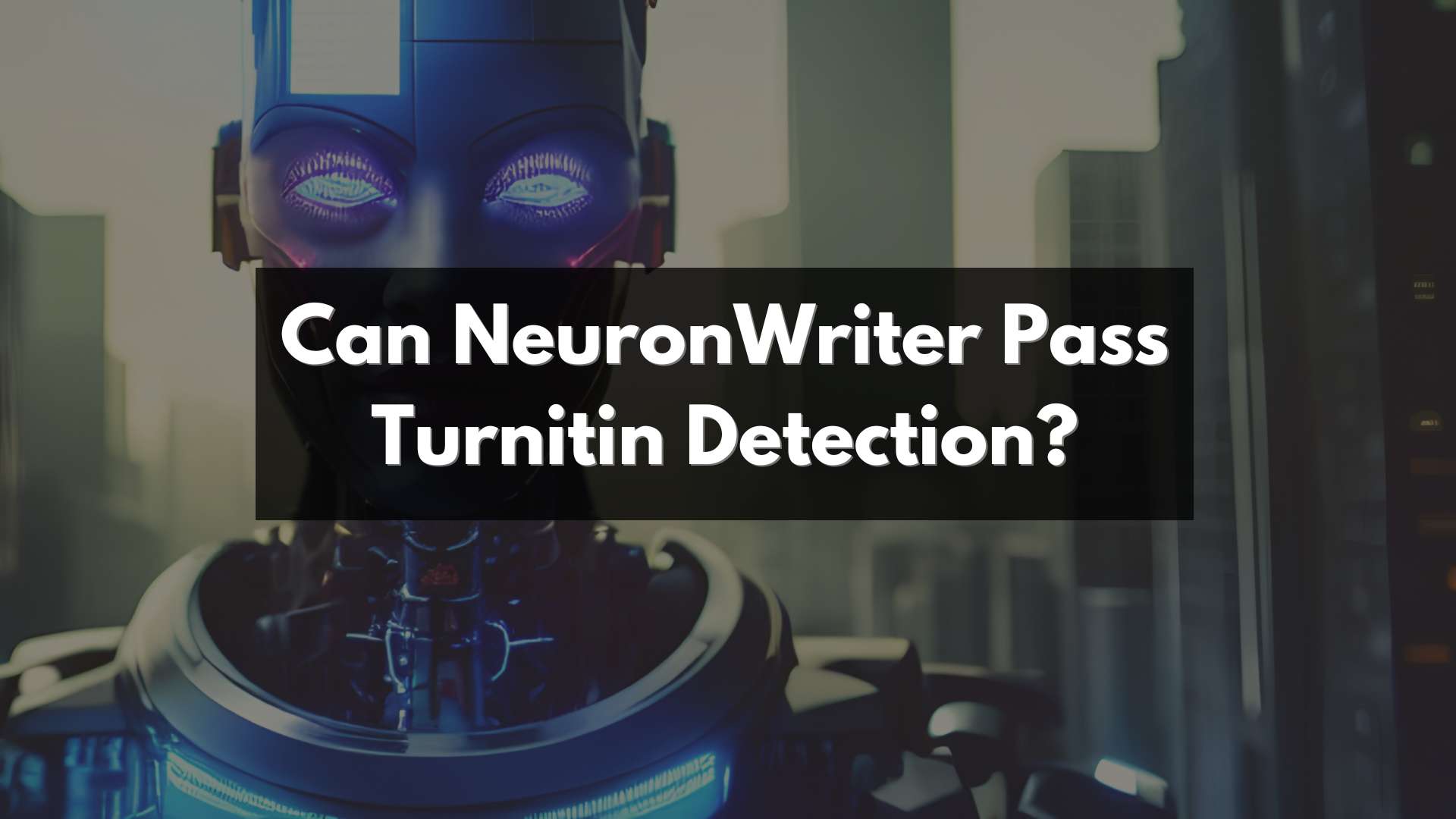Can NeuronWriter Pass Turnitin Detection?
Looking for the inside scoop on AI content tools like NeuronWriter and Turnitin’s detection capabilities? Here’s a startling truth: Turnitin is now equipped with AI technology that can detect even AI-generated text.
This article aims to dive deep into this hot topic, discussing whether NeuronWriter can bypass Turnitin’s sharp-eyed scan. Ready for a reality check? Let’s plunge in!
Key Takeaways
- Turnitin uses advanced AI technology and algorithms to detect even AI-generated text, making it highly unlikely for NeuronWriter or similar tools to bypass its detection system effectively.
- Turnitin’s algorithms are specifically designed to identify patterns and markers indicative of AI-generated content, including popular models like ChatGPT.
- Using AI chatbots like NeuronWriter for essays poses significant risks, compromising academic integrity and facing penalties such as failing grades, expulsion from educational institutions, damage to reputation, legal consequences, and professional ramifications. It is important for students to prioritize authenticity and develop critical thinking skills rather than relying solely on automated tools.
How Turnitin Detects Plagiarism
Turnitin uses advanced technology and algorithms to detect similarities between submitted content and existing sources, allowing it to identify potential cases of plagiarism.
The technology behind Turnitin
Turnitin, a robust plagiarism detection software, relies on an intricate blend of AI and extensive databases to discover any unoriginal or suspicious content. It scans student submissions against millions of academic papers, books, reputable journals, and internet pages for similarity.
The cutting-edge technology also includes ChatGPT-trained systems that can spot AI-generated text with impressive accuracy of 98%, flagging less than 1% false positives. Its sophisticated algorithms not only check for direct matches but also identify paraphrased sections which are often overlooked by other scanners.
This makes it almost impossible for even advanced tools like NeuronWriter to escape Turnitin’s scrutiny.
Algorithms used for similarity detection
Turnitin, a leading plagiarism detection tool, employs advanced algorithms to detect similarities in text documents. These algorithms compare submitted content against a vast database of academic sources, online publications, and student papers.
Using machine learning techniques and pattern recognition, Turnitin’s algorithms analyze linguistic patterns, sentence structure, word choices, and the overall composition to identify potential instances of plagiarism.
With its sophisticated technology, Turnitin can accurately pinpoint similarities even if the text has been paraphrased or slightly modified. The system boasts an impressive accuracy rate of 98%, ensuring that it rarely generates false positives.
So when it comes to evaluating whether an AI content writing tool like NeuronWriter can bypass Turnitin’s detection systems for AI-generated content, it is important to note that Turnitin’s algorithms have been specifically designed to identify such content.
Can NeuronWriter Pass Turnitin Detection?
NeuronWriter’s ability to pass Turnitin detection is highly questionable due to Turnitin’s advanced AI writing detection capabilities.
Exploring the capabilities of NeuronWriter
NeuronWriter is an AI content writing tool that has gained attention for its ability to generate high-quality text quickly. However, when it comes to bypassing AI content detection systems like Turnitin, the picture becomes a bit more complicated.
Turnitin’s advanced algorithms are specifically designed to detect AI-generated content, including that generated by NeuronWriter.
Turnitin’s AI writing detection capabilities can identify patterns and markers indicative of AI-generated text. In fact, Turnitin has even released its own AI writing detection solution to ensure the integrity of academic work.
ChatGPT, a popular AI model often used in essay generation, is also within the reach of Turnitin’s detection system.
It’s important for students and writers to be aware that these plagiarism detectors have an accuracy rate of 98% and less than 1% false positives. While there may be other tools available in the market claiming to bypass such detections, relying solely on NeuronWriter or similar tools could put academic integrity at risk.
Analyzing the effectiveness of AI in bypassing Turnitin
AI tools like NeuronWriter have gained popularity for their ability to generate content quickly and efficiently. However, when it comes to bypassing Turnitin’s plagiarism detection system, the effectiveness of AI is questionable.
Turnitin has advanced algorithms specifically designed to detect AI-generated content, including that generated by NeuronWriter.
Turnitin’s AI writing detection solution can identify if an essay has been composed using popular models like ChatGPT, which are trained on academic writing. This means that even if students try to use these AI tools for their essays, there is a high likelihood that Turnitin will flag them as potential cases of plagiarism.
Turnitin boasts a remarkable accuracy rate of 98% and less than 1% false positives in detecting plagiarized content. While innocent students may occasionally be affected by this system, its efficiency cannot be denied.
It is important for students to understand the risks and consequences associated with using AI chatbots or other similar tools for academic writing. Academic integrity and ethical concerns should be prioritized over seeking shortcuts or cheating attempts.
The Risks and Consequences of Using AI Chatbots for Essays
Using AI chatbots for essays poses significant risks and consequences, including compromising academic integrity and facing penalties for plagiarism. Educational institutions are increasingly implementing anti-cheating measures to detect AI-generated content and discourage dishonest practices among students.
Academic integrity and ethical concerns
Academic integrity is a fundamental aspect of education, and ethical concerns arise when it comes to using AI content writing tools to bypass AI content detection. Plagiarism not only undermines the credibility of one’s work but also violates academic integrity.
Turnitin’s AI detection system plays a crucial role in maintaining fairness and honesty in academia by identifying AI-generated content, including that produced by NeuronWriter.
Turnitin’s goal is to ensure originality in academic writing, and any attempt to deceive the system can have severe consequences for students. Penalties for plagiarism can range from failing grades to expulsion from educational institutions.
The rise of AI chatbots raises questions about the misuse of technology and its impact on academic honesty.
It is important for students to understand the risks associated with using such tools as it goes beyond just getting caught by detection software. Academic dishonesty not only devalues their own learning experience but erodes trust within educational institutions as well.
It is essential for students to prioritize authenticity and develop their critical thinking skills rather than relying solely on automated tools.
Penalties for plagiarism
Plagiarism is a serious offense in academic writing, and the consequences can be severe. If an AI content writing tool like NeuronWriter attempts to bypass AI content detection and is caught by Turnitin or other plagiarism scanners, the following penalties may apply:
- Academic Disciplinary Actions: Educational institutions have strict policies against plagiarism, and if detected, students may face disciplinary actions such as failing the assignment, receiving a lower grade for the course, or even expulsion from the institution.
- Damage to Reputation: Plagiarism tarnishes one’s academic reputation. It can impact future academic and professional opportunities, as integrity is highly valued in educational and professional settings.
- Legal Consequences: Plagiarism can lead to legal disputes if copyrighted material is used without proper attribution or permission. Copyright holders have the right to take legal action against those who infringe on their intellectual property.
- Professional Ramifications: Plagiarism can have long-lasting effects on one’s career prospects. Employers value honesty and originality, so being associated with plagiarism can harm future job prospects.
- Ethical Concerns: Plagiarism goes against principles of academic integrity and ethical standards. It undermines the learning process by discouraging critical thinking and originality.
Implications for educational institutions
The implications for educational institutions concerning the use of AI content writing tools and their ability to bypass AI content detection are significant. With Turnitin’s advanced technology in detecting AI-generated content, it becomes evident that utilizing such tools, like NeuronWriter or ChatGPT, may not be a foolproof way to avoid detection.
Turnitin’s system is specifically designed to identify AI-generated text and has an impressive accuracy rate of 98% with minimal false positives.
This poses ethical concerns for academic integrity and raises questions about the consequences for students who resort to using these tools as a means of cheating. Educational institutions have implemented anti-cheating measures, including Turnitin itself, as a way to maintain fairness in assessment processes.
If caught using AI-generated content or plagiarized essays, students can face serious penalties that may impact their academic progress.
It is crucial for educational institutions to educate students about proper citation and referencing techniques while promoting originality in academic writing. Encouraging students to develop their critical thinking skills and fostering a culture of integrity will ultimately benefit both individual learners and the overall reputation of educational institutions.
Tips for Ensuring Originality in Academic Writing
Understand citation and referencing, practice proper paraphrasing techniques, and utilize plagiarism detection software to ensure originality in academic writing.
Understanding citation and referencing
Citation and referencing are essential components of academic writing. They serve to acknowledge the sources of information that you have used in your paper, giving credit to the original authors and allowing readers to explore those sources if they wish. Here are some key points to understand about citation and referencing:
- Use proper citation styles: Different academic disciplines often require specific citation styles, such as APA, MLA, or Chicago. Familiarize yourself with the style guide recommended by your institution and ensure that you follow it consistently throughout your paper.
- Include in-text citations: Whenever you directly quote or paraphrase someone else’s work, provide an in-text citation that includes the author’s name and the year of publication. This allows readers to identify which ideas or information came from external sources.
- Create a reference list: At the end of your paper, include a reference list that provides detailed information about each source you cited in your paper. The format for reference lists varies depending on the citation style used.
- Cite all types of sources: In addition to citing books and scholarly articles, remember to cite other types of sources like websites, reports, or interviews if you use information from them in your writing.
- Understand plagiarism rules: Plagiarism occurs when you use someone else’s work without proper acknowledgment or attribution. By understanding how to effectively cite and reference sources, you can avoid unintentional plagiarism and maintain academic integrity.
Proper paraphrasing techniques
Paraphrasing is an essential skill in academic writing, and it’s important to understand the proper techniques to ensure originality. Here are some tips for effective paraphrasing:
- Understand the source material: Before attempting to paraphrase a passage, make sure you fully comprehend the original text. Highlight key points and take notes to help you grasp the main ideas.
- Use different words and sentence structure: When paraphrasing, avoid simply replacing a few words with synonyms. Instead, rephrase the entire sentence using your own words and sentence structure while maintaining the original meaning.
- Change the order of information: Rearrange the order of ideas presented in the original text when paraphrasing. This helps prevent direct copying and encourages greater engagement with the material.
- Focus on expressing ideas: Rather than replicating every detail from the source, concentrate on conveying the main concepts in your own words. This demonstrates your understanding of the subject matter.
- Provide proper citation and referencing: Even though you are paraphrasing, it is still necessary to provide appropriate citations for all sources used in your work. Referencing avoids plagiarism accusations by acknowledging the original authors’ contributions.
- Turnitin’s AI detection system can identify AI – generated content, including paraphrased text.
- Properly paraphrased content should not trigger plagiarism detection systems like Turnitin.
- Using an AI content writing tool does not guarantee successful bypassing of AI content detection systems.
- Turnitin has a high accuracy rate of 98% in detecting potential plagiarism cases.
- It is important for students to develop their own paraphrasing skills rather than relying solely on AI tools to avoid academic misconduct allegations.
Utilizing plagiarism detection software
Plagiarism detection software is an essential tool for students and researchers to ensure the originality of their academic work. Here are some tips on how to effectively utilize plagiarism detection software:
- Choose a reliable plagiarism detection tool: There are various plagiarism detection software available, both free and paid. Look for a trusted and reputable tool that provides accurate results.
- Run your work through the software before submission: Before submitting your essay or research paper, always scan it through the plagiarism detection software. This will help you identify any potential instances of unintentional plagiarism or similarities with other sources.
- Understand the interpretation of similarity reports: Plagiarism detection software generates similarity reports that highlight matching text from different sources. Learn how to interpret these reports and differentiate between intentional copying and properly cited information.
- Use multiple plagiarism checkers: To ensure thorough checks, it is recommended to use multiple plagiarism detection tools. Different tools may have varying databases and algorithms, which can increase the chances of detecting potential instances of plagiarism.
- Review flagged areas carefully: If the software flags any sections as potentially plagiarized, carefully review these sections to determine if they require proper citation or paraphrasing. Make necessary revisions to maintain academic integrity.
- Keep track of your sources: Maintain a comprehensive list of all the sources you have used in your work, including books, articles, websites, and other relevant materials. Properly cite and reference these sources using a recognized citation style (e.g., APA, MLA).
- Seek guidance from instructors or writing centers: If you are unsure about how to use plagiarism detection software effectively or need assistance in understanding its results, reach out to your instructors or writing centers for guidance and support.
Conclusion
In conclusion, while NeuronWriter may have impressive AI capabilities, it is unlikely to pass Turnitin’s detection system. Turnitin has developed advanced algorithms specifically designed to identify AI-generated content and maintain academic integrity.
As students and institutions navigate the challenges of plagiarism prevention, it remains crucial to prioritize originality in academic writing and utilize proper citation techniques.
FAQs
1. Can NeuronWriter guarantee that my paper will pass Turnitin detection?
While NeuronWriter is a powerful AI writing assistant, it cannot guarantee that your paper will pass Turnitin detection as the software’s algorithms are constantly evolving. However, NeuronWriter can assist you in creating original and well-structured content.
2. How does NeuronWriter help with avoiding plagiarism?
NeuronWriter provides suggestions and recommendations to enhance your writing skills and ensure your content is original and properly cited. It helps to prevent unintentional plagiarism by suggesting alternative phrasing, paraphrasing techniques, and providing guidance on proper citation methods.
3. Can I trust the accuracy of citations generated by NeuronWriter?
NeuronWriter generates citations based on established citation styles such as MLA or APA. While it strives for accuracy, it is always important to review the generated citations yourself or consult relevant style guides to ensure compliance with specific requirements set forth by your institution or publisher.
4. Is using AI writing assistants like NeuronWriter considered cheating?
Using AI writing assistants like NeuronWriter is not considered cheating as long as you use them ethically and responsibly. These tools are designed to support writers in generating ideas, improving their writing skills, and enhancing productivity. However, it is essential to understand how to appropriately incorporate the assistance provided into your own work while giving credit where necessary through proper referencing practices.





